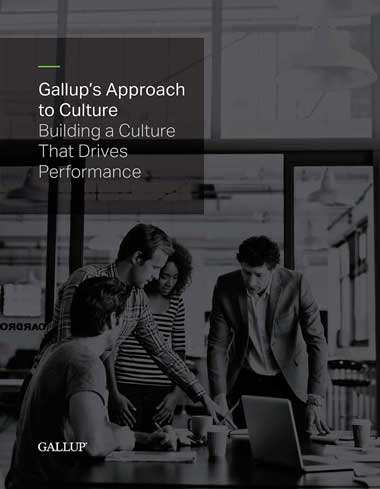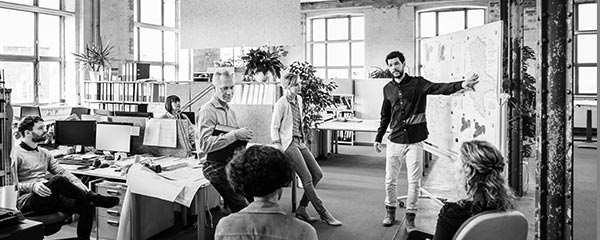Story Highlights
- Use HR's unique skills to coach mindsets and build agile teams
- HR must incentivize courage -- but most workers hesitate to speak up
- Doing, not training, creates an innovative culture
Gallup research shows that fewer than one in three U.S. employees believe that they are encouraged to come up with new and better ways of doing things. No wonder the U.S. is 8th on Bloomberg's list of World's Most Innovative Countries in 2019 -- in 2018 the U.S. didn't even make the top 10.
In today's hyper-competitive business environment, this is a serious setback for businesses -- especially because so many organizations believe they are focusing on innovation.
More likely, many organizations' innovation initiatives are dead before they're officially put in play. A recent McKinsey survey found that, "While many companies are striving to become agile, only 4% of survey respondents have completed an organization-wide transformation. The No. 1 problem they cite is culture."
Agility is critical for innovation. Agility, after all, is about evolving processes and systems as well as mindsets -- a crucial prerequisite to build a culture that breeds innovation.
An agile HR function can play a significant role in this effort. But to do so, HR needs to set aside old ways of thinking, replace legacy processes and systems, and kick-start an innovative mindset.
Doing this starts with HR shifting its perception of itself. Here's how HR can reinvent itself, based on Gallup research, to lead the agile transformation their companies must make:
1. HR should establish communication channels that allow employees to share information.
Innovation requires a shared vision, purpose and set of attitudinal values that unite all employees. However, Gallup research shows that only about one in three employees in the U.S. feel that, in their company, they can openly share information, knowledge and ideas.
To enable agility, HR can play a leading role in supporting scrum teams, cross-functional sprints or hackathons to get employee together to solve problems, test products or design new solutions. But the role that HR plays shouldn't end there.
To create a culture of innovation, HR must bury the traditional notion that training can solve all problems ... many innovation training programs and innovation days are forgotten shortly after participants leave the classroom.
By supporting and developing -- or inventing, if necessary -- communities of practice, HR can help these communities or "team alumni" stay connected, learn from each other, and make sense of cultural and attitudinal-change challenges that arise from implementing agile approaches.
It is important to note that the role of a genuinely agile HR function is not merely that of a moderator of agile meetings. HR should contribute to agile functions by developing people and teams, focusing on continued coaching, and providing learning opportunities beyond the conclusion of agile sprints and projects.
2. HR should replace training with doing.
To create a culture of innovation, HR must bury the traditional notion that training can solve all problems. In our experience, many innovation training programs and innovation days are forgotten shortly after participants leave the classroom. Limited investment, implementation and understanding prevent real, lasting mindset shifts.
HR's ongoing, real-time support of experiential learning and collaborative sharing lets employees at all levels test and learn from their experiences.
Innovation programs may seem collaborative but are, in reality, strictly top-driven initiatives -- the antithesis of agility. This may reflect a focus on risk aversion, but that's an attitude that routinely undermines innovation.
HR must play a fundamental role here by replacing training with doing. HR's ongoing, real-time support of experiential learning and collaborative sharing lets employees at all levels test and learn from their experiences.
As the central conduit that helps facilitate agile working effectively and people development beyond the sprint, HR must play a crucial role in aligning leaders, agile teams, coaches, project managers and scrum masters. But true agile results from whole-organization alignment. If doing agile is the responsibility of a select few roles, the potential for innovation is minimized. HR should expand the universe of doers to maximize innovation and provoke a permanent mindset shift.
3. HR should be role models of fearlessness.
HR should elicit courage from leadership to the front lines by seeking out and dismantling the structures that make employees afraid to bring up new ideas or make bold decisions.
Innovation is a trial-and-error process, but Gallup research shows that only about two in 10 U.S. employees (21%) feel their company creates an environment where people can try, fail and learn from mistakes. And just a little more two in 10 (22%) feel that, in their company, people closest to the action are trusted to make decisions.
Fearlessness is a crucial aspect of innovation, and the power of individual innovation and ideation cannot be overlooked.
The smallest idea generated by an employee has the potential of becoming a game-changer for the organization. Voicing those ideas requires a culture that incentivizes speaking up. HR should boldly and publicly support those incentives.
4. HR should actively coach teams to adapt an innovative mindset.
HR's skillset -- people coaching, organizational development, culture, change training and development skills -- is a vital resource for organizational transformation in general. But as agile coaches, HR could zero in on specific obstacles for teams and individuals, helping to change mindsets, reframing existing mental models, and dispelling biases.
The people element is critical in any kind of technological or strategic change, and the HR role is vital in the cultural shift that is required to drive organizational agility. But to become innovation champions, HR leaders would also need to reskill themselves -- they'll need facilitation skills, process and systems awareness, and change-leadership skills.
Systems thinker, Peter Senge, talks of the need for leaders to function as "networkers" who move freely throughout the organization. He tasks these networkers with finding those who are predisposed to change and helping with organizational experimentation and the diffusion of learning.
But employees need the right environment in which to incubate the ideas, as well as the right coaching, support, and training to translate an idea into real-world application and impact.
Who better than HR to create an environment and provide the tools needed to make this a reality?
Gallup can help you craft an agile, innovative workplace culture:
- Download our approach to workplace culture perspective paper.
- Learn how we can partner with you to create a culture of agility across your organization.




